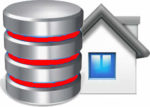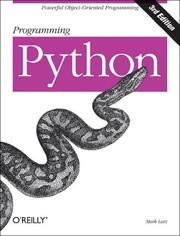The Classic Python Book Updated for Today’s Pythonista
You can tell a Pythonista by the astonishment he or she displays
when viewing code in other languages, generally followed by the exclamation,
“Why does it have to be so complicated?” If that’s not evidence enough, look for
comp.lang.python among his bookmarks. But the surest sign (short of asking) is
the book he clutches in his hands. Your true Pythonista will keep the latest
edition of Programming Python (Lutz, O’Reilly) within reach. No other resource
explains the Python language syntax and programming techniques so thoroughly, or
in as clear and concise a manner.
The new third edition of Programming Python has been updated to reflect current
best practices and the abundance of changes introduced with the latest version
of the language, Python 2.5. “There have been important changes in both the
Python language and Python practice in the past five years which necessitated an
update,” says author Mark Lutz. “For instance, language features such as nested
function scopes, string methods, and list comprehensions clean up a lot of code
and have been incorporated throughout. I also updated many of the examples to be
more feature-rich, and added new materials on topics such as the new email and
XML packages, SQL and ZODB databases, PIL imaging tools, and so on, to make the
book more practical. Many of these changes reflect feedback from the Python
classes I teach.”
Lutz points out that Python’s popularity has grown much over the last five
years, and new tools and techniques have emerged. “This edition has been updated
to make is more useful as an application-level programming tutorial,” he notes.
“Once readers have studied the material, they’ll be able to apply Python to real
applications-level tasks: building web sites, coding GUIs, wrapping C libraries,
doing system administration, and so on.”
The book is written for people who already know the fundamentals of the Python
language, but want to learn how to apply it to real programming tasks such as
GUIs, databases, and the Internet. This book picks up where Learning Python
leaves off, and gives the other half of the Python story: what you can do with
it after you learn it.
Readers will learn how to apply Python in real-world problem domains such as GUI
programming, parallel processing, networked applications, Internet scripting,
and database management. Programming Python, Third Edition covers each of these
target domains gradually, beginning with in-depth discussions of core concepts,
and then progressing toward complete programs.
“In some sense, this book is to applications-level programming what Learning
Python is to the core language: a gradual tutorial, which makes no assumptions
about your background in the common domains it covers, and teaches programming
in those domains from the ground up,” says Lutz. “For instance, Internet
scripting is introduced gradually, beginning with network sockets and ending
with discussions of full web frameworks. GUIs get a similar treatment with one
introductory and two tutorial chapters.
“Larger examples are presented, but only after their techniques have been
covered,” Lutz adds. “Language topics such as OOP and code reuse show up as
well, but in the context of realistic programs. Primarily, this book is for
readers who want to learn the fundamentals of common Python domains, as well as
study it in action in those domains.”
If you’re interested in Python programming, this O’Reilly classic needs to be
within arm’s reach. You won’t find it sitting unused on a Pythonista’s
bookshelf. The wealth of practical advice, snippets of code, and patterns of
program design can all be put into use on a daily basis, making the lives of
Python programmers easier and more productive.

